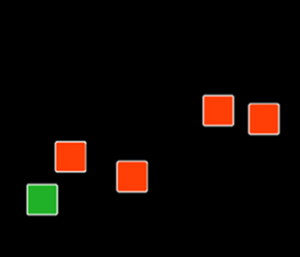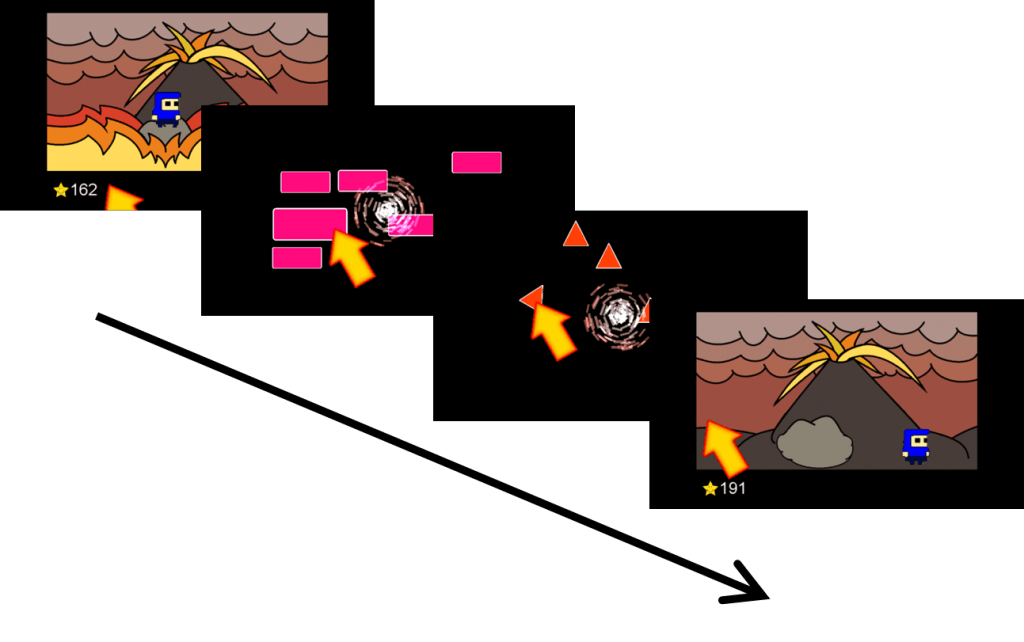The week before last I was in Lincoln to visit the University and give a presentation on the progress we have been making with our research at the WESC Foundation to the School of Psychology’s Perception, Action and Cognition group. I talked about some of the rehabilitation strategies used for people with low vision and about our project to develop a computer game that could be used for rehabilitating people with visual field loss.
 The premise of our game is centered around the “visual search task”, which involves finding a target object in a visual display of distracting objects. In the picture on the right the distracting objects differ from the target by one feature only: colour (i.e. the target object is a green square and the distracting objects are orange squares). Simpler tasks involve finding a target that differs from the distracting objects by more than one feature (e.g. colour and shape: the target is a green square amongst orange circles). More complicated tasks involve multiple groups of distractors that share different features with the target (e.g. the target is a green square amongst orange squares and green circles).
The premise of our game is centered around the “visual search task”, which involves finding a target object in a visual display of distracting objects. In the picture on the right the distracting objects differ from the target by one feature only: colour (i.e. the target object is a green square and the distracting objects are orange squares). Simpler tasks involve finding a target that differs from the distracting objects by more than one feature (e.g. colour and shape: the target is a green square amongst orange circles). More complicated tasks involve multiple groups of distractors that share different features with the target (e.g. the target is a green square amongst orange squares and green circles).
Previous research has demonstrated that adult stroke patients with visual field loss such as hemianopia can train using visual search tasks to improve their functional vision. The mechanism for this rehabilitation is unclear and may depend on developing new eye movement strategies (compensatory visual scanning), improving visual perception and attention (perceptual training), or restoring small areas of the visual field (visual restitution therapy). However, typically visual search tasks are quite dull and unable to engage people for the long periods required for the rehabilitation to generate a significant improvement in vision. Our project aims to improve engagement and motivation by implementing the visual search task as part of an interactive computer game.
The game is still early in development and we are constantly involving potential users in the design process for input and feedback so it is all subject to change. At the moment there are three levels of gameplay: short-term, mid-term, and long-term. Short-term gameplay consists of immediate reward for finding the correct target in the visual search task such as sound and particle effects. Mid-term gameplay consists of adding some meaning to the visual search task. In the image above, the player has to find the target objects to progress passed a river of lava. Long-term gameplay consists of adding an element of progression to the game. In the current version of the game the player has to make their way through twelve different levels to reach the boat that will allow them to escape the island and complete the session for that day. As rehabilitation can take many weeks there will also be an additional extra-long-term (or replayability) element, which consists of a calendar that can visualise progress over time.
It is important to determine whether using computer game technology to make rehabilitation more engaging is a viable and effective strategy for young people with visual field loss as well as for adults. We intend to perform a pilot study next year to test the efficacy of the game as a rehabilitation tool and determine what effects the rehabilitation has on functional vision and whether these skills transfer to natural tasks and have a real impact on patients’ quality of life.
